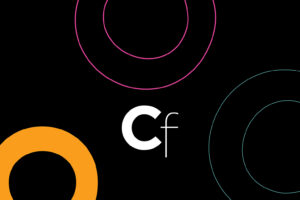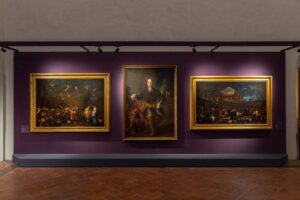Will the Real Cimabue Please Stand Up?


PARIS — Long lionized as the first breakthrough painter of the early Renaissance, Cimabue has rarely been the subject of monographic exhibitions. With only 12 works securely attributed to him currently, many of which are too fragile to travel, a full retrospective remains a logistical impossibility. For this reason, A New Look at Cimabue at the Louvre offers a once in a lifetime opportunity to see numerous works by this legendary artist in a single room.
Cimabue catalyzed the fleshy, emotive style that would become a trademark of the early Renaissance. Alas, earlier generations of art historians, from Giorgio Vasari in the 16th century to Raimond van Marle at the turn of the 20th, overzealous in their quest to celebrate this breakthrough, sometimes reduced him this vanguard role. Vasari famously wrote in his study The Lives of the Most Excellent Painters, Sculptors and Architects (first published 1550) that amid the inferior art of the 13th century, Cimabue “shed the first light on the art of painting.” Although the Louvre opens this exhibition with one of the few extant copies of Vasari’s landmark 1568 manuscript, curator Thomas Bohl and his team know that the artist never aspired to be the first incremental step toward a high Renaissance style he would never see, so they set out to grapple with Cimabue on Cimabue’s terms.
The show is located in a large room known as the Salle Rosa, at the end of the Louvre’s hall of Italian painting in the Denon Wing; at the heart of it is the colossal altarpiece known as the “Maesta” (1280). Roughly contemporaneous pieces by several other early Renaissance painters round out the exhibition, showcasing the status of Italian painting before Cimabue. Visitors can then reconsider the artist’s paintings and explore how Duccio and Giotto became emboldened by the earlier artist’s legacy to imbue their respective compositions of Christ’s passion cycle and the stigmata of St. Francis with more theatrically, naturalism, and three dimensionality.

Why stage a Cimabue show in 2025? Recent conservation of two works in the Louvre’s collection, the “Maesta” and a smaller devotional panel known as the “Mocking of Christ” (1285–90), motivated the museum to reintroduce them. The Louvre secured coveted loans from New York, London, and cities in Italy. The dramatic results of the cleanings called for a scholarly re-assessment, best achieved by bringing these works together under one roof.
In fact, the total effects of the conservation are so dramatic that before and after photos should be on view. For example, the cleaning has revealed the extent to which heavy-handed overpainting from the 19th century distorted Cimabue’s subtler chromatic and luminous effects in the “Maesta.” In Francesco Bini’s pre-restoration photo, the Madonna’s robes are a dull, muddied navy. Now restored to a luminous bright blue, they showcase the gem grade lapis lazuli blue pigment that Cimabue used; the blue feathers in the angels’ wings likewise shimmer.

Several passages of the painting that were once burgundy are now a stunning magenta. Cimabue did not intend for the Virgin’s lower robe, nor for the angels’ wings and vestment, to appear as gradations of light to dark burgundy. A 19th-century restorer appears to have gotten carried away, perhaps by that 19th-century predilection for deep dark reds that is still widely associated with the Victorian era. This 21st-century restoration recreates the plumish-red hues Cimabue’s intended, cognizant of his keen eye for mixing ultramarine, red lake, and white in other works.
Other revelations include how the Christ child’s left leg peers through a thin, white transparent swath of drapery. Previously, this small white undergarment was entirely opaque. Several lines in the“Maesta” are now far more defined, most noticeably in the throne, which was hard to read visually in the past. Overall, the painting is brighter and crisper, with more nuanced color.
The cleaning also uncovered Arabic calligraphy in the red band of the picture frame, which an earlier restoration obscured. Cimabue’s intention here was most likely decorative; it is unlikely that he understood the words that he was copying from another source. Although these pseudo-inscriptions do not coalesce into coherent sentences, three words occasionally recur: ٱلْعَلِيُّ (Al-Aliyy, the exalted and the high), ٱلْمَلِكُ (Al-Malik, the King or Sovereign), and سلطان (Al-Sultan, authority). The first two are on the list of the 99 beautiful names of Allah.

In framing the “Maesta” with an Arabic pseudo-inscription that few of its original viewers in its church context could read, Cimabue was appealing to the vogue for decorative art with Arabic calligraphy in 13th-century Pisa. Although this trend is not widely publicized, many early Italian paintings feature Arabic pseudo-inscriptions, drawing inspiration from objects and textiles imported from Southwest Asia and North Africa. As a nod to this oraesthetic, the exhibition includes a 13th-century Syrian cup, drawn from the Louvre’s permanent collection, with a similar red band and gold Arabic script.
“Mocking of Christ,” which depicts soldiers taunting and slapping Christ right before the crucifixion, may not compete with the “Maesta” in scale, but its poetic intensity stands out as breathtakingly audacious for the late 13th century. Because it was meant for private devotion, Cimabue could work far more subtly. The Louvre’s small, intimate panel is displayed alongside its companion panels: The Frick’s “Flagellation” and a miniature version of the “Maesta” from London’s National Gallery.

Cimabue took great care to differentiate each soldier in the composition. Some are older, with gray hair and beards. Others are young and clean shaven, with brown or blond hair. The vestments’ alternating colors distinguish every figure. No two faces are alike — each flashes a different grimace as they compete with one another for the next strike on Christ. Cimabue carefully illustrates how the frenzied mob is composed of distinct actors; there is no parallel in the 13th-century art for a scene with this level of individuation and brutality.
Although earlier scholars like Vasari and van Marle mythologized Cimabue as the genius who inaugurated Renaissance painting, many of today’s scholars focus on how the church’s tastes in devotional art were changing. Over the course of the 1200s, the Franciscan and Dominican orders revolutionized western Christianity from within. The latest scholarship sees an echo of these theological mutations in Cimabue’s artistic mutations.
The Louvre’s curators cleverly gesture toward this changing contemplative theology by exhibiting Meditations on the Life of Christ, a 14th-century manuscript composed by an unknown author for a group of Franciscan nuns known as the Poor Clares. Its invitation to vividly picture the life of Christ in the mind’s eye as a devotional practice was becoming a widespread phenomenon in 13th-century Christianity.

The friars wanted Cimabue to paint emotive and fleshy figures to coax viewers into such expressive imaginings of the life of Christ. In the 21st century, prayer can feel like texting a god who never answers back directly. In the 13th century, prayer was a more cinematic exercise. Imagine a movie of Jesus’s life (hopefully better than one by Mel Gibson) within the mind’s eye to get closer to God. The Friars turned to Cimabue to create artworks that might deepen this imaginative process, commissioning him to create a vivid Maesta for vistors to view at Pisa’s church of San Francesco de’ Ferri. In a dynamic digital reconstruction by a team of scholars, Rechichi, Cooper, Giles, Bevilacqua, the extent to which the Franciscans were seeking to broadly popularize this new way of picturing Christ becomes evident.
Thomas Bohl has taken great care in his curating to move beyond the genius myth of Cimabue, separating the man from the legend, to reveal more about his original context. The catalog, unfortunately but predictably published in French only, courageously connects the artist’s breakthrough style with friars’ burgeoning taste for naturalism and the pivot toward more cinematic contemplative practices in the 13th century. The Louvre has outdone the Metropolitan Museum of Art and the National Gallery in London, whose Siena exhibition did not go far enough to recognize the new scholarly consensus about the influence of contemplative theology. As American and British museums struggle to adapt to seismic shifts in the history of early Renaissance painting, the French are leading the way in how to rewrite art history and how to redefine an Old Master exhibition.



A New Look at Cimabue continues at the Louvre Museum (Rue de Rivoli, Paris, France) through May 12. The exhibition was curated by Thomas Bohl.






